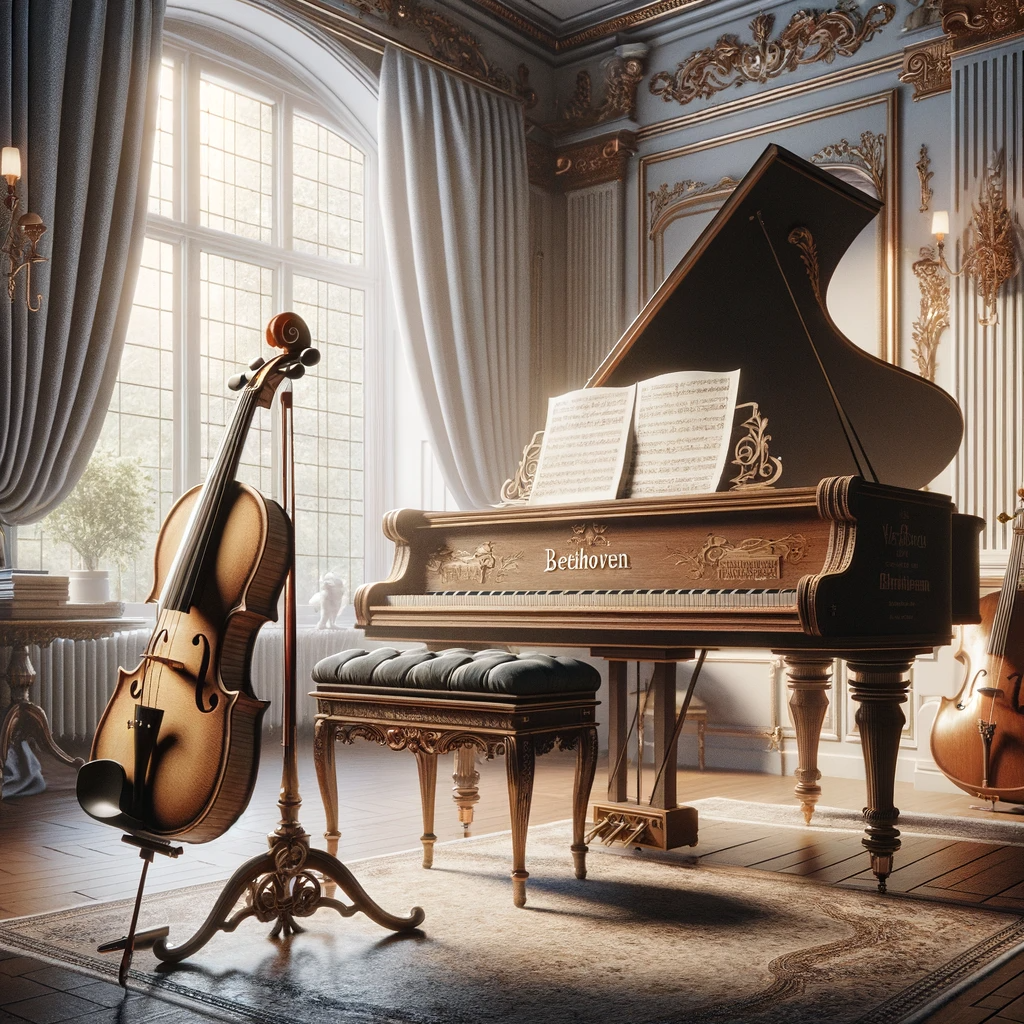
Beethoven’s Violin Sonatas: An Instrumental Symphony
Introduction to Beethoven’s Violin Sonatas
Ludwig van Beethoven, a name synonymous with classical music’s revolutionary transformation, composed ten violin sonatas over his lifetime. These pieces, often overshadowed by his symphonies and piano sonatas, represent a critical evolution in the partnership between the violin and the piano. The violin sonatas of Beethoven are not just accompaniments or solo performances but a conversation between two powerful voices.
Early Developments and Influences
Beethoven’s journey with violin sonatas began in the classical era, a time when the piano was rapidly evolving. His early sonatas, especially the first three op. 12, show influences from his predecessors like Mozart. However, even in these early works, Beethoven’s innovative spirit shines through. He began to push the boundaries of the traditional sonata form, experimenting with structures and harmonic progressions.
The Sonata No. 5 in F Major “Spring”
The “Spring” Sonata, as it is affectionately known, marks a turning point in Beethoven’s approach to the violin sonata. Here, the violin and piano engage in a lyrical dialogue, each instrument sharing the spotlight. The sonata’s name, not given by Beethoven but by the public, reflects the work’s freshness and vivacity. The opening movement, with its rich melodic lines, sets the stage for a sonata that is as much a celebration of the violin as it is of the piano.
The Collaborative Nature of the Middle Sonatas
As Beethoven’s style matured, his middle-period sonatas, particularly op. 30, no. 1-3, exhibit a more profound partnership between the violin and piano. These sonatas show an equal distribution of thematic material, a departure from the traditional dominance of the piano. The violin no longer merely accompanied but conversed, argued, and harmonized with the piano. This period also saw Beethoven experimenting with tonality, rhythm, and form, pushing the capabilities of both instruments.
The Late Sonatas and Their Legacy
Beethoven’s late violin sonatas, especially the op. 96 in G Major, showcase his fully developed compositional style. Here, the dialogue between the violin and piano becomes more intricate and intimate. This sonata, with its subtle dynamics and thematic complexity, anticipates the romantic era’s expressiveness and technical demands. Beethoven, in these late works, paved the way for composers like Brahms and Schumann to explore the violin sonata’s potential further.
The Enduring Impact of Beethoven’s Violin Sonatas
The violin sonatas of Beethoven stand as a testament to his genius in understanding and exploiting the potential of instrumental collaboration. They are not just compositions for two instruments but conversations between equal partners, each with its voice and character. Beethoven’s violin sonatas have left an indelible mark on the landscape of classical music, influencing generations of composers and performers.
The Interplay of Emotions and Techniques
Emotional Depth in Beethoven’s Sonatas
Beyond the technical innovations, what stands out in Beethoven’s violin sonatas is the emotional depth he infused into the compositions. Each sonata seems to narrate a distinct story, reflecting Beethoven’s own life experiences and emotional states. The depth of expression found in these pieces is a clear departure from the more formal and restrained style of his predecessors.
The Role of the Piano
It’s crucial to emphasize the evolution of the piano’s role in these sonatas. Initially, the piano part was primarily accompaniment, with the violin leading the melodic charge. However, as Beethoven progressed, he elevated the piano to an equal partner. This change was partly due to the technological advancements in piano construction during Beethoven’s lifetime, which allowed for a more expansive range and dynamic capabilities.
Technical Challenges and Innovations
Beethoven’s violin sonatas are renowned for their technical demands on both musicians. The integration of complex rhythms, intricate finger work for the violinist, and demanding passages for the pianist were groundbreaking at the time. These challenges require a high level of skill and understanding between the musicians, further emphasizing the sonatas’ collaborative nature.
Influence on Future Composers
The legacy of these sonatas can be seen in the works of later composers. The way Beethoven treated the violin and piano as equals was revolutionary and influenced the likes of Johannes Brahms, who continued to explore this partnership in his own violin sonatas. Moreover, Beethoven’s bold harmonic experiments and structural innovations opened new avenues for musical expression and form.
Performance and Interpretation
Interpreting Beethoven’s violin sonatas is a complex task. Each piece demands not only technical proficiency but also a deep understanding of Beethoven’s stylistic nuances and emotional language. The best performances of these sonatas are those that capture the conversation between the violin and piano, each instrument responding and contributing to the narrative.
Beethoven’s Sonatas in the Modern Repertoire
Today, Beethoven’s violin sonatas remain a staple in the repertoire of violinists and pianists worldwide. They are celebrated for their depth, complexity, and the unique partnership they showcase between the two instruments. These pieces continue to challenge and inspire musicians, offering endless possibilities for interpretation and expression.
Conclusion: A Timeless Musical Dialogue
In conclusion, Ludwig van Beethoven’s violin sonatas are not just significant works in the classical music canon; they represent a turning point in the history of musical composition. These sonatas exemplify a perfect balance between technical mastery and emotional depth, offering a rich, dialogic interplay between violin and piano. Their enduring appeal lies in their ability to convey profound human emotions through a complex yet harmonious partnership of instruments. As we continue to explore and perform these works, we uncover new layers of meaning and beauty, reaffirming Beethoven’s genius and his lasting impact on the world of music.